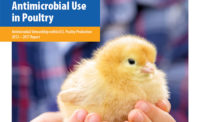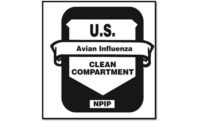The National Poultry Improvement Plan (NPIP) was established in response to a need to control diseases whose existence was incompatible with the development of a modern poultry industry. Several important disease organisms are transmitted vertically from hens to chicks through the eggs. This makes the spread of the diseases almost impossible to control.
In the early 1900s, two of the important disease organisms with which most breeding flocks were infected were Salmonella pullorum, which causes Pullorum disease, and Salmonella gallinarum, which causes Fowl Typhoid.
In 1935, the NPIP was founded for the purpose of devising and implementing a program to eradicate these two organisms from commercial breeding stock in the United States. This effort was so successful that soon additional NPIP programs were developed for the eradication of other important vertically transmitted pathogens from the commercial poultry industry. The pathogenic mycoplasmas, which cause primarily respiratory diseases, essentially have been eliminated from the commercial broiler and turkey industries through the NPIP programs. In recent years, monitoring and control programs for avian influenza and Salmonella enteritidis have been introduced as part of the NPIP.
The positive impact of these disease control and eradication programs on the success of the U.S. poultry industry cannot be overestimated. The diseases on which NPIP has focused its efforts are those diseases which would have prevented the development of the huge industry we see today.
The poultry industry leaders of the early 1900s recognized that, in order for a modern poultry industry to grow and thrive, certain poultry diseases had to be eliminated from the breeding and production systems. The remarkable good health of the U.S. poultry flocks and the incredible quality of U.S. poultry products today are a tribute to the successful contributions of the NPIP programs.
The NPIP also serves as one of the fundamental elements of interstate commerce, insuring that participating flocks, hatching eggs and chicks are safe for shipment freely within the U.S.
But the impact of the NPIP does not stop at America’s borders. It is estimated that approximately 60 percent of the world supply of poultry breeding stock originates in the U.S. Poultry companies all over the world import breeding stock from primary breeding companies in the U.S. with confidence that the imported breeders will be free of the NPIP program diseases.
Approximately $346 million in export sales of breeding stock and hatching eggs was realized by U.S. companies in 2012. This would not be possible without the NPIP. Globally, the NPIP is considered as the “gold standard” for poultry disease control programs, and many countries have developed programs patterned from the NPIP model.
From its beginning, the NPIP was structured as a cooperative program between the federal government, the states and the poultry industry. This structure has been the key to its tremendous success and is vital to it meeting the challenges of the future.
The NPIP is governed by the General Conference Committee (GCC). The GCC serves as an official advisory committee to the U.S. Secretary of Agriculture on matters pertaining to poultry health. The Secretary has advisory committees from each commodity group, and the members of those committees are appointed by the Secretary. The GCC is unique because its members are elected by the NPIP delegates. This has provided the GCC the flexibility to develop, implement and revise programs in ways that are most effective for the poultry industry, responsive to changing needs and highly cost-effective.
The NPIP delegates, through the GCC, recommend all new NPIP programs and program standards to the Secretary. If approved, these are then published in the Code of Federal Regulations and become part of the law of the land. This semi-independence from the U.S. Department of Agriculture by the GCC is viewed by our trading partners very favorably, because the NPIP is seen as a highly credible, transparent and non-political third party on issues related to poultry diseases.
Although the NPIP has been very successful in eliminating and controlling poultry diseases in the U.S., these diseases have only been eliminated from the commercial poultry industry. They all likely still exist in backyard and hobby flocks. As the interest in backyard poultry increases and the number of small flocks expands around the country, the danger of disease introduction into the commercial poultry industry is increasing.
The NPIP programs are one of the main barriers to prevent the disastrous re-emergence of some of these old diseases. The NPIP is an indispensable pillar upon which the future of the poultry industry rests and should be supported and strengthened for the challenges ahead.



